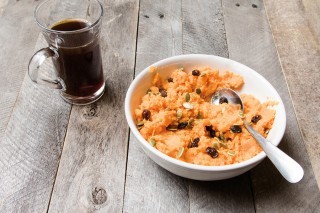Fueling Tips and Recipes for Before, During and After a Workout

Apple Sweet Potato Mash, Photo: Courtesy of VeloPress
Adapted with permission of VeloPress from “Rocket Fuel: Power-Packed Food for Sports and Adventure” by Matthew Kadey, RD. Try free recipes at rocketfuelfoods.net.
If you’ve worked up the motivation to drag yourself off the couch for another training session, good for you—that’s half the battle. The other essential half of the workout equation is eating the right foods. Thankfully, fueling your workouts isn’t rocket science. Dial in your nutrition before, during and after exercise with these simple guidelines and recipes.
Before
Eating properly before exercise can help you work at a higher intensity for longer, resulting in greater performance gains in the long run. Here are some important tips to follow for your pre-workout nutrition:
Take a test drive
Before a big event, experiment with different types, quantities and timing of food during your training sessions. This way you can pinpoint what works (and doesn’t) for you. For instance, some athletes can eat a larger amount of food closer to their workouts without bringing on digestive woes.
Clockwork
Aim to consume a larger meal that contains a good balance of carbohydrates, protein and healthy fats 2 to 3 hours before a workout, and then follow this up with a smaller snack consisting of 150 to 300 calories 30 to 60 minutes before training. This gives you enough time to digest the meal and also provides a little pre-workout energy boost.
Not so fast
When gearing up for a sweat sesh, research suggests that opting for a lower-glycemic-index nibble before working out can bring about performance benefits. A low-glycemic snack (such as apple slices with nut butter or low-fat yogurt with berries) will raise your blood sugar more slowly, resulting in sustained energy as well as improved fat burning. Save the sugary chews and gels for during your race or training session.
Less is more
Too much fiber, protein and fat in your pre-workout nosh can weigh you down. That’s because these items slow down digestion and can result in digestive discomfort during exercise. So put away the bean soup or grilled steak for another time.
Recipe: Apple Sweet Potato Mash
High in complex carbohydrates, the sweet spud can provide some long-lasting energy for your impending exercise pursuit. But there’s no need to put your workout on hold while you roast or boil one up when this nifty microwave mash gets the job done quickly. Some add-ins, such as maple syrup, applesauce and crunchy pumpkin seeds, provide more motivation to work out.
Dairy-free, Gluten-free, Paleo-friendly, Vegan or Vegetarian
Servings: 1
Active Time: 10 min.
Although digestion rates vary, you’ll likely perform better if you give yourself 30 minutes or more for digestion.
1 medium-sized sweet potato, peeled and cubed
1/3 cup plain applesauce
2 teaspoons pure maple syrup
1/4 teaspoon ground allspice
1/4 teaspoon ground ginger (optional)
1 tablespoon raisins
1 tablespoon raw shelled pumpkin seeds (pepitas)
Place sweet potato cubes and 1 tablespoon water in a microwave-safe bowl. Cover with plastic wrap and poke a few holes in the plastic to allow for venting. Microwave on high for 6 minutes, or until potato is fork-tender. The bowl will be very hot, so use oven mitts or a dish towel to remove from microwave.
Add applesauce, maple syrup, allspice and ground ginger (if using) to bowl and mash together. Top with raisins and pumpkin seeds.
Game Changers: Replace applesauce with pear sauce. Mash in cinnamon instead of allspice. Use dried cranberries instead of raisins. Swap out pumpkin seeds for sunflower seeds.
The post Fueling Tips and Recipes for Before, During and After a Workout appeared first on Competitor.com.
Ryan Hall's Blog
- Ryan Hall's profile
- 21 followers



